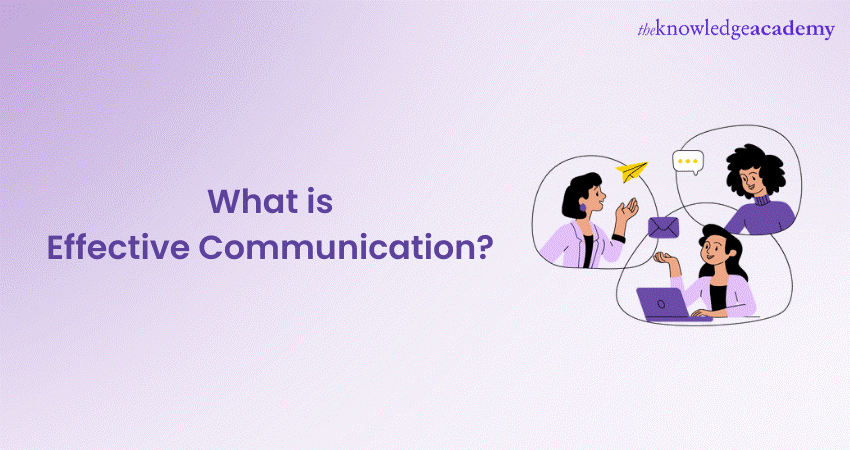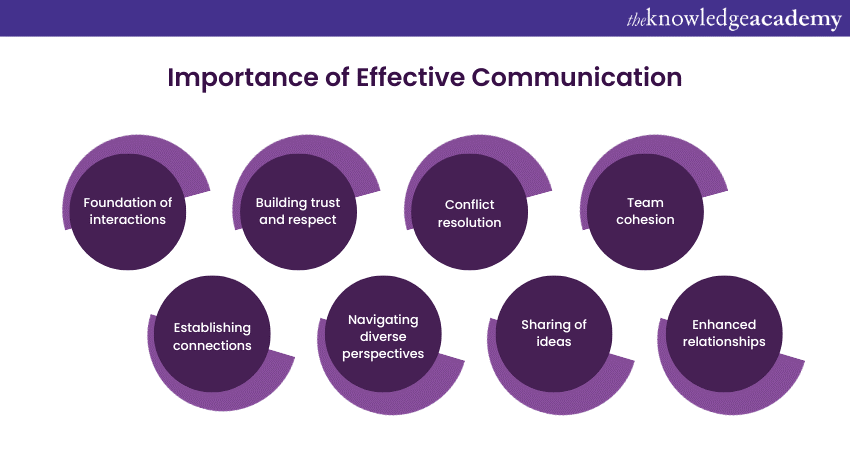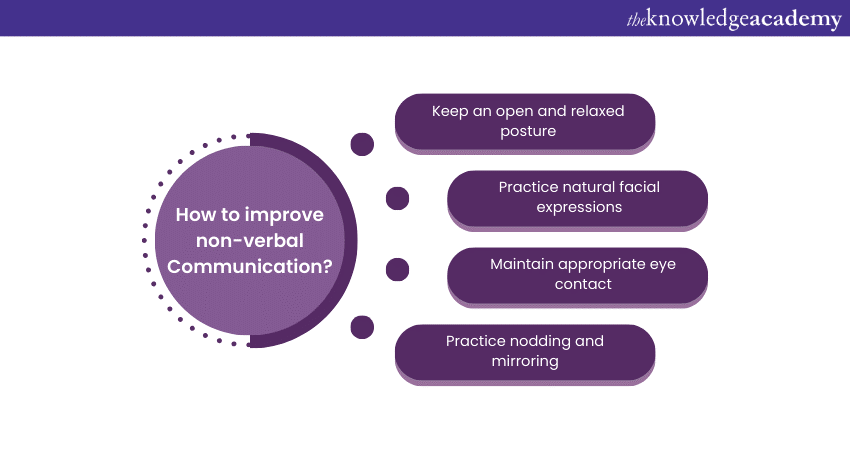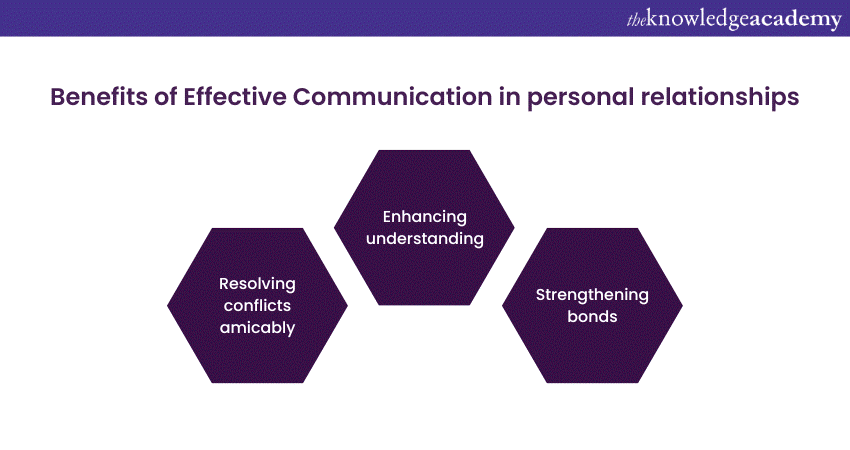We may not have the course you’re looking for. If you enquire or give us a call on 01344203999 and speak to our training experts, we may still be able to help with your training requirements.
Training Outcomes Within Your Budget!
We ensure quality, budget-alignment, and timely delivery by our expert instructors.

Have you ever wondered, “What is Effective Communication?” Grasping this concept is crucial as it plays an important role in fostering strong relationships and navigating diverse aspects of our lives successfully. It goes beyond just a mere exchange of words; it’s about articulating information clearly and creating a conducive atmosphere for dialogue and collaboration. Diving into the meaning of Effective Communication is not just for those looking to bolster professional or personal relationships; it’s for anyone eager to delve into the depth of meaningful dialogue.
Gaining insights and adopting practical tools ensure that every interaction is fruitful and every conversation is a step towards mutual understanding and connection. Mastering Effective Communication is a cornerstone in our journey through the complex landscape of human interaction, leading us towards a society where every voice resonates, every message is comprehended, and growth and connection are at the heart of every discourse. But let’s pause for a moment – what exactly defines Effective Communication? This blog aims to explore what is Effective Communication, highlight its key principles, and equip you with valuable strategies to hone your communication skills.
Table of Contents
1) Defining Effective Communication
2) Key principles of Effective Communication
3) Strategies to enhance Effective Communication
4) Practical applications of Effective Communication
5) Overcoming barriers to Effective Communication
6) Conclusion
Defining Effective Communication
Let’s get into the depth of what communication truly entails, going beyond the mere exchange of information to explore the essence of understanding emotions and intentions. Here, we’ll discuss the significance of conveying messages in a manner that fosters understanding trust, and leads to desired responses, laying the foundation for strong relationships in various aspects of life.
Effective Communication meaning
When we delve into the concept of what Effective Communication is, it becomes clear that it’s not just about exchanging information. It’s about grasping the emotions and intentions that accompany the spoken words. The meaning of Effective Communication envelops the capacity to articulate a message in such a manner that it is not only received but also wholly understood by the intended audience, thereby eliciting the desired response or action. This involves a two-way process: transmitting a message effectively and ensuring it is received correctly, a delicate dance between the sender and the receiver.
At its core, Effective Communication hinges on mutual understanding, a shared comprehension between individuals that transcends mere words. It’s about fostering a connection, a common ground where ideas, thoughts, and feelings are exchanged seamlessly. In this space, the meaning behind every message is explored, discovered, and appreciated, contributing to richer, more fulfilling interactions.
Unlock the power of Effective Communication with our Effective Communication Skills Training – Sign up now!
Why is Effective Communication important?
Understanding the importance of Effective Communication reveals that it serves as the bedrock of our daily interactions.

1) Foundation of interactions: Effective Communication is the foundational element of all our interactions, serving as the bedrock upon which we build relationships, both personal and professional.
2) Building trust and respect: It plays a crucial role in fostering an environment of mutual trust and respect, essential components for any successful relationship.
3) Conflict resolution: Effective Communication is indispensable in resolving conflicts, helping parties involved understand differing perspectives and find common ground.
4) Team cohesion: In professional settings, it is vital to construct cohesive and collaborative teams, thereby contributing to a more harmonious and productive workplace.
5) Establishing connections: The ability to communicate effectively facilitates the establishment of fruitful and enduring connections, forming the basis of strong, resilient relationships.
6) Navigating diverse perspectives: It acts as a bridge, connecting diverse thoughts, emotions, and viewpoints, ensuring that messages are not just transmitted but are truly understood and valued.
7) Sharing of ideas: Effective Communication encourages the free sharing of ideas and the establishment of a common ground, fostering an environment where mutual respect and understanding can flourish.
8) Enhanced relationships: Recognising and harnessing the power of Effective Communication is essential for anyone seeking to navigate the complexities of interpersonal relationships and establish meaningful connections.
Key principles of Effective Communication
The key principles of Effective Communication encompass clarity, active listening, and acknowledging non-verbal cues, forming the foundation for mutual understanding and successful interaction. These principles guide the way we convey and interpret messages, ensuring that our communications are clear, meaningful, and effective.
Clarity and conciseness
At the heart of Effective Communication lies the principle of conveying messages with clarity and conciseness.
1) Simple language: Employing straightforward and accessible language is critical. This practice eliminates ambiguity, creating an environment where messages are easily understood and interpreted by the audience.
2) Avoiding jargon: When communicating with a diverse group, it becomes essential to either simplify or thoroughly explain any industry-specific terms, promoting a sense of inclusivity and comprehension among all participants.
3) Straight to the point: Bypassing lengthy and unnecessary explanations helps maintain the integrity of the core message, thus reducing the risk of misunderstandings and sustaining the audience’s interest.
Adherence to clarity and conciseness eliminates ambiguity, thereby fostering an environment of understanding and mutual respect. It lays the groundwork for the receiver to interpret the message as intended, paving the way for productive conversations.
Listening actively
Listening actively is a multifaceted aspect of communication, requiring more than just hearing the spoken words.
1) Full concentration: Offering undivided attention and focusing entirely on the speaker can significantly enhance the interaction, leading to a more profound connection and understanding.
2) Understanding and responding: This involves not only acknowledging the spoken words but also interpreting the emotions and intentions behind them, followed by a thoughtful and relevant response.
3) Remembering: The ability to remember and refer back to previously discussed points showcases a level of engagement and respect that can deepen the relationship between the communicators.
By embracing active listening, we cultivate mutual understanding and respect, creating a dialogue that is as much about receiving as it is about transmitting information.
Non-verbal communication
Non-verbal elements in communication often convey more information and insight than the actual spoken words.

1) Body language: The importance of body language, including posture and gestures, is paramount. These non-verbal cues can either support or contradict the spoken message, hence the need for awareness and control.
2) Eye contact: Maintaining appropriate eye contact signals interest and engagement, fostering a sense of trust and openness in the conversation.
3) Facial expressions: Expressions like smiling, frowning, or raised eyebrows communicate a wide range of emotions, providing additional context to the spoken words.
Acknowledging the impact of non-verbal cues is essential, as they convey volumes about our intentions and feelings. Being aware of and proficient in non-verbal communication enhances our ability to communicate effectively, ensuring our messages are comprehended in their entirety.
Master the unspoken language with our Nonverbal Communication Training – Sign up today!
Strategies to enhance Effective Communication
Now, let’s talk about the methodologies that can be employed to elevate the way we interact, focusing on fostering empathy, establishing robust feedback mechanisms, and adeptly adjusting communication styles to align with diverse audience needs and expectations. These strategies are integral for forging deeper connections, fostering mutual understanding, and ensuring messages are conveyed effectively.
Empathy and understanding
Harnessing empathy and understanding in communication is instrumental in recognising and valuing diverse perspectives, thereby creating a foundation of trust and rapport.
1) Acknowledging perspectives: Actively acknowledging and valuing others’ viewpoints builds a landscape of inclusivity and mutual respect, vital for meaningful interactions.
2) Attentiveness to emotions: Probing beneath the surface to understand emotional undertones enhances responsiveness and fosters deeper connections.
3) Building rapport: The cultivation of understanding and empathy nurtures a harmonious relationship, laying the groundwork for trust and fruitful collaboration.
By emphasising empathy, we build rapport and trust, fostering an environment where different perspectives are valued and respected. This strategy lays the foundation for meaningful and enriched interactions.
Discover the art of influential Communication for a brighter future with our Communication Skills Training – Sign up now!
Feedback mechanism
The incorporation of a robust feedback mechanism is essential in confirming the accurate reception of messages and swiftly addressing any discrepancies or misunderstandings that may arise.
1) Verifying understanding: Regular confirmation that the communicated message is accurately understood is imperative, safeguarding against misunderstandings and ensuring clarity.
2) Addressing issues promptly: A well-structured feedback loop facilitates immediate resolution of issues, smoothing the communication pathway and enhancing mutual understanding.
3) Enhancing communication: Consistent feedback serves as a tool for refining communication strategies, optimising the communicative experience for both sender and receiver.
Implementing a solid feedback mechanism guarantees that both sender and receiver are on the same page, enhancing the overall effectiveness of communication and reducing the scope for errors.
Adjusting communication style
Consciously adjusting your communication style to resonate with the audience's unique preferences, expectations, and cultural context is a cornerstone of Effective Communication.
1) Awareness of preferences: Discerning and adapting to the audience’s communicative preferences ensures the message is well-received and impactful.
2) Adapting to expectations: Aligning communication with the audience’s expectations heightens message relevance and strengthens communicative bonds.
3) Cultural nuances: Acknowledging diverse cultural expressions and sensitivities enriches the interaction, establishing a foundation of mutual respect and shared understanding.
Being flexible and adjusting your communication style ensures that your message resonates with the audience, paving the way for mutual understanding and respect. It’s a step towards making every interaction more impactful and meaningful.
Practical applications of Effective Communication
Let’s understand how Effective Communication principles are instrumental in diverse settings such as the workplace, personal relationships, and education. This section elucidates how employing these principles can foster collaboration, deepen understanding, and create positive environments in various aspects of life.
In the workplace
Implementing Effective Communication strategies within the workplace is fundamental, promoting a collaborative atmosphere, enhancing productivity, and alleviating conflicts.
1) Fostering collaboration: Clear and concise communication lays the groundwork for a cooperative environment, allowing for seamless teamwork and shared goals.
2) Boosting productivity: Efficient communication streamlines processes, reduces misunderstandings, and ultimately elevates organisational output.
3) Mitigating conflicts: Prompt and empathetic resolution of issues, facilitated by open communication channels, contributes to a harmonious workplace.
In personal relationships
Employing principles of Effective Communication within personal relationships is pivotal for nurturing understanding, solidifying bonds, and resolving disagreements in a constructive manner.

1) Enhancing understanding: Active listening and empathetic responses in personal interactions lead to a deeper appreciation of each other’s perspectives.
2) Strengthening bonds: Transparent and respectful communication is the bedrock of strong, enduring relationships.
3) Resolving conflicts amicably: Open dialogue and constructive feedback are key in addressing and resolving disputes harmoniously.
Transform conflicts into opportunities with our Conflict Resolution and Negotiation for Change Training.
In education
The role of Effective Communication within the educational landscape is indispensable, acting as a catalyst for enriched learning experiences, increased student engagement, and fostering a positive academic environment.
1) Facilitating learning: Clear communication between educators and learners simplifies complex concepts, enhancing comprehension and retention.
2) Encouraging participation: Inclusive and encouraging communicative practices foster an environment where students feel valued and are more likely to contribute.
3) Building a positive learning environment: A harmonious classroom atmosphere, cultivated through respectful and open communication, is conducive to academic success.
Overcoming barriers to Effective Communication
Overcoming barriers to Effective Communication is essential for fostering clear and mutual understanding in diverse interactions. This involves identifying obstacles like language differences and cultural disparities, adapting communication strategies, and continually refining skills through feedback and learning.
Identifying barriers
Identifying barriers, including language differences, cultural disparities, and technological glitches, is pivotal in streamlining communication.
1) Language differences: Recognising and addressing language disparities are vital for preventing misunderstandings and fostering clarity in dialogue.
3) 2) Cultural disparities: A keen awareness of and respect for cultural differences facilitate mutual understanding and harmonious interaction.
Technological glitches: Proactively addressing and rectifying technological issues ensure uninterrupted and Effective Communication.
Adaptation and learning
Strategic adaptation to varied communication scenarios and extracting lessons from past experiences are invaluable in navigating communication barriers.
1) Scenario adaptation: Being versatile and adapting communication strategies to suit different scenarios enhance interaction quality.
2) Learning from experiences: Reflecting on and learning from past communication experiences contribute to skill enhancement and barrier navigation.
3) Enhancing skills: Continuous learning and adaptation refine communication skills, making interactions more resilient to obstacles.
Seeking feedback and improving
The pursuit of feedback and a commitment to continuous improvement are fundamental in honing communication skills and surmounting barriers.
1) Feedback seeking: Actively seeking and valuing feedback provide insights into areas of improvement, enabling refined communication strategies.
2) Continuous improvement: Dedication to ongoing refinement of communication skills fosters proficiency and versatility in interactions.
3) Barrier overcoming: Consistent improvement and adaptation contribute to the elimination of communication barriers, enhancing overall interaction quality.
Conclusion
At the outset, we asked, "What is Effective Communication?" Through our exploration, it's evident that Effective Communication is a cornerstone of successful interactions in today's interconnected world. From understanding its intricate nuances to implementing strategies and overcoming barriers, its significance spans workplaces, personal relationships, education, and beyond. As we advance in our personal and professional journeys, grasping and implementing the principles of Effective Communication will remain pivotal. Embracing this art not only amplifies our individual engagements but also paves the way for collective growth and mutual understanding.
Frequently Asked Questions
Upcoming Business Skills Resources Batches & Dates
Date
 Assertiveness Skills Training
Assertiveness Skills Training
Fri 10th May 2024
Fri 14th Jun 2024
Fri 12th Jul 2024
Fri 9th Aug 2024
Fri 13th Sep 2024
Fri 11th Oct 2024
Fri 8th Nov 2024
Fri 13th Dec 2024







 Top Rated Course
Top Rated Course



 If you wish to make any changes to your course, please
If you wish to make any changes to your course, please


